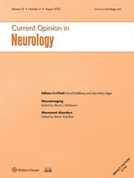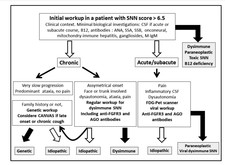Sensory neuronopathies, diagnostic criteria and causes
SNN involve paraneoplastic, dysimmune, toxic, viral and genetic mechanisms. About one-third remains idiopathic. Recently, new antibodies and genes have reduced this proportion. Anti-FGFR3 and anti-AGO antibodies are not specific of SNN, although SNN is predominant and may occur with systemic autoimmune diseases. These antibodies are the only marker of an underlying dysimmune context in twothirds (anti-FGFR3 antibodies) and one-third of the cases (anti-AGO antibodies), respectively. Patients with anti-AGO antibodies may improve with treatment, which is less clear with anti-FGFR3 antibodies. A biallelic expansion in the RFC1 gene is responsible for the cerebellar ataxia, neuropathy, vestibular areflexia syndrome (CANVAS) in which SNN is a predominant manifestation. Most of the patients have an adult onset and are sporadic. The RFC1 mutation may represent one-third of idiopathic sensory neuropathies. Finally, the criteria for the diagnosis of paraneoplastic SNN have recently been updated.




